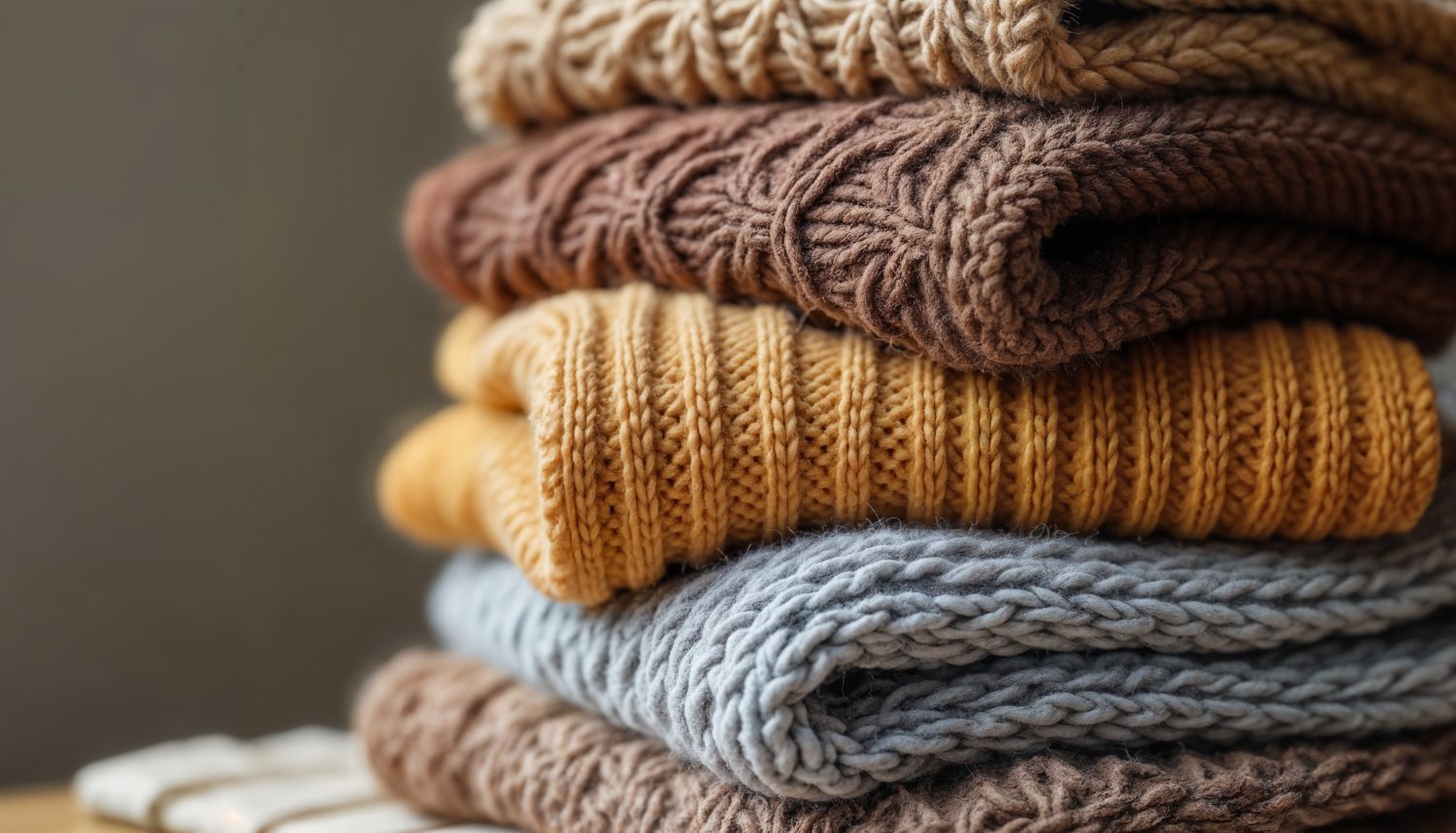How to Wash and Dry Your Knitwear to Keep it Soft and Snuggly
 We all have those items in our closet we instinctively know to hand wash — delicate blouses, lace lingerie, maybe a vintage tee we’ve had forever. And then there’s knitwear. Soft, cozy, and usually a bit high maintenance, knits are the pieces we love to live in but dread washing.
We all have those items in our closet we instinctively know to hand wash — delicate blouses, lace lingerie, maybe a vintage tee we’ve had forever. And then there’s knitwear. Soft, cozy, and usually a bit high maintenance, knits are the pieces we love to live in but dread washing.
If you’ve ever ruined a beloved sweater and swore you’d never let it happen again, this guide is for you. We show you how to wash and dry your favorite knits the right way, so they stay soft, snuggly, and perfectly shaped all season long.
Step 1 | Check the Care Label First
Before you even fill the sink or start sorting your laundry, stop and read the care label. Knitwear comes in many types (e.g., wool, cashmere, acrylic, alpaca), and each fiber has different needs. Some sweaters can be hand washed at home, while others may require dry cleaning. The label will tell you if a garment is safe to wash, what temperature to use, and whether to avoid tumble drying.
Pay attention to these indicators on your knitwear’s tag:
- Washing symbols: Look for icons like a hand in a tub (hand wash), a circle (dry clean only), or a tub with numbers (machine washable and temperature limits).
- Fabric content: Knowing if your item is 100% wool, a wool blend, or synthetic makes a big difference in care strategy.
- Special instructions: Some knits come with notes like “reshape while damp” or “lay flat to dry” — these are non-negotiable if you want your item to last.
Step 2 | Use Cold or Lukewarm Water Only
Heat is one of knitwear’s worst enemies. Hot water can shrink natural fibers, weaken elasticity, and make soft textures feel coarse. So when washing knits, stick to cold or lukewarm water to protect the fibers and preserve the shape and softness.
Here’s how to choose the right temperature:
- Cold water (60–80°F): Safe for all types of knitwear and great for preventing color bleed and shrinkage.
- Lukewarm water (up to 86°F): Best for wool and cashmere, offering a gentle clean without shocking the fibers.
- Avoid hot water: Even synthetic knits can stretch, warp, or fade if exposed to excessive heat.
Step 3 | Choose a Wool-safe or Delicate Detergent
Not all laundry detergents are safe for delicate knits. Standard detergents often contain enzymes, brighteners, or heavy surfactants that strip natural oils and roughen the fibers. For knitwear, especially wool or cashmere, use only a wool-safe or delicate-specific detergent.
To help you pick the best product, here’s what to look for:
- Mild, pH-neutral formula: Avoid anything too acidic or alkaline, it can harden fibers and cause color fading.
- Enzyme-free: Enzymes can damage proteins in wool and silk.
- Labels that mention wool, cashmere, or delicates: Brands like The Laundress Wool & Cashmere Shampoo, Eucalan, or Woolite Delicates are formulated for gentle care.
Using the right detergent helps maintain the softness of your knitwear while removing dirt without harsh friction or chemical damage.
Step 4 | Turn Inside Out Before Washing
Before you submerge your sweater or load the washing machine, flip your knitwear inside out. This simple step minimizes wear and tear during the wash cycle and helps preserve surface texture and color. It also helps protect embroidered or printed designs.
Here are a few key reasons to always turn your knits inside out:
- Prevents pilling: Friction on the outer fibers can create those annoying little fabric balls.
- Preserves appearance: Inside-out washing helps protect the finish of the outer surface.
- Protects detailing: Any stitching, beading, or patterns will be less exposed to agitation.
Step 5 | Wash by Hand or Use a Mesh Bag in the Machine
Hand washing is the gold standard for cleaning knitwear. But if you’re short on time or dealing with a bulkier item, machine washing can work, as long as you do it right. A mesh laundry bag adds a protective layer, reducing the agitation and stretch risk.
Here’s how to approach both methods with care:
- Hand wash: Fill a clean sink or basin with cold/lukewarm water and detergent. Submerge the knit, gently agitate with your hands, and soak for about 10 minutes.
- Machine wash (last resort): Place the item into a mesh bag and use the gentle or wool cycle with cold water and low spin speed.
- Avoid overloading: Wash one or two knit items at a time to avoid crowding and friction.
Step 6 | Never Wring or Twist Wet Knitwear
After washing, it’s tempting to twist your garment to get rid of excess water, but resist that urge. Wet knitwear is at its most vulnerable and can stretch permanently when wrung. Instead, press out the water gently.
Here’s how to do it without damaging your sweater:
- Roll it in a towel: Lay the item flat on a clean, dry towel, roll it up like a burrito, and press down to absorb moisture.
- Gently press, don’t squeeze: Pat or press out water with your hands while supporting the garment from underneath.
- Avoid dripping: Letting knitwear hang while wet can drag down the fabric and distort its shape.
Step 7 | Lay Flat on a Towel or Mesh Rack to Dry
Once you remove excess water, lay your knitwear flat to dry. Hanging is not an option here; gravity stretches wet fibers and leaves shoulders sagging. A clean towel or mesh drying rack gives your garment support while allowing air to circulate.
Here’s how to get it right:
- Use a fresh, dry towel or breathable mesh rack.
- Reshape the garment: While it's still damp, gently stretch it back to its original measurements and align the sleeves, hem, and collar.
- Flip midway: If using a towel, flip the sweater after several hours to ensure even drying and avoid mildew.
Step 8 | Keep Away from Direct Heat and Sunlight
Drying your knitwear near a heater or in direct sun may speed things up, but it comes at a cost. Heat and UV rays can fade colors, stiffen fibers, and cause shrinkage, especially in natural materials like wool and alpaca.
For safe, effective drying, follow these tips:
- Choose a well-ventilated space: Dry indoors or in the shade with good airflow.
- Keep away from radiators or vents: Avoid placing garments near baseboard heaters or window sills with strong sunlight.
- Avoid heated drying racks: Stick to room temperature drying surfaces.
Step 9 | Store Folded (Never on Hangers)
The final step in keeping your knitwear soft and snuggly is proper storage. Hanging may be fine for jackets, but knits stretch under their own weight, especially at the shoulders. Folding is the way to go to maintain shape and avoid warping.
Here are the best ways to store knits so they last longer:
- Fold and stack gently: Don’t overcrowd shelves; let pieces breathe.
- Use breathable containers: Cotton bins or cloth storage bags work better than plastic.
- Add natural moth repellents: Cedar blocks or lavender sachets can protect against pests.
Your Sweaters Are in Good Hands — Schedule a Professional Cleaning With Arrowhead Cleaners & Laundry Today!

Knitwear behaves nothing like your everyday tees and jeans. Its yarns relax when wet, fibers tangle under heat, and delicate weaves pill if spun the wrong way. Which means one careless wash or stain treatment can mean disaster for that favorite cashmere or hand-knit sweater.
At Arrowhead Cleaners & Laundry, we offer expert dry cleaning for everything from everyday sweaters to delicate pieces (e.g., wedding dresses, leather jackets, etc.), always handled with care to avoid shrinkage or fabric damage. As a family-owned and operated business, we’ve built our legacy on precision, care, and customer satisfaction.
For added convenience, you can also opt for our Pickup and Delivery Service. We’ll come right to your door in Bismarck or nearby areas like Lincoln, Southport, and Highland Acres. Trust your knitwear to the professionals. Schedule your dry cleaning or laundry service with Arrowhead Cleaners & Laundry!

